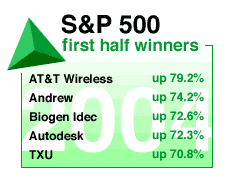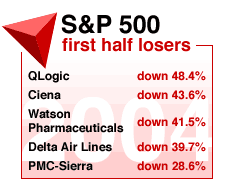NEW YORK (CNN/Money) -
It seems like the second half of 2004 should be better than the first. But 'seems' is the key word here.
Granted, there are reasons to be optimistic. There's the tendency of election years to be good for the market, in particular, the last seven months of election years. There's the likely continued strength of the economy and corporate earnings.
There's also the fact that the last few days of the first half brought answers to many of the questions that have kept investors jittery of late. Specifically, the Coalition Provisional Authority handed over power in Iraq to a temporary government and the Federal Reserve boosted the fed funds rate for the first time in more than four years.
But the once frequent chorus of market watchers assuring investors that the second half will be better has cooled a bit lately, with new questions providing uncertainty.
Namely, who will win the U.S. presidency? What will happen with Iraq now that the transitional government has taken over? Will oil prices continue to decline? Are stocks too expensive, or will earnings prove strong enough to enable further stock gains, even as rates are rising? How much more will the Fed raise rates and is the market prepared for it?
First-half heroes and villains
After a wham-bam '03, stocks ping-ponged through the first half of '04, with some wildly speculative Internet stocks zooming and some old favorites spinning their wheels as investors focused on interest rates, oil prices and Iraq.

Despite all the tumult and uncertainty, the major indexes closed the first-half with little to show. The Dow lost 0.2 percent, the Nasdaq gained 2.2 percent and the S&P 500 gained 2.6 percent. However, plenty of stocks clocked in with new 52-week highs and lows, and there were certainly trends in terms of which sectors stood out and which ones languished.
On one hand, the half year marked an interest in defensives, with energy and industrials the best performing sectors, and materials and information technology the worst performing sectors.
But break that down to individual industries and you have Internet software and wireless telecom as some of the best performers and gold and broadcasting and cable some of the worst.

On the S&P 500, AT&T Wireless (AWE: Research, Estimates), Autodesk (ADSK: Research, Estimates) and Andrew (ANDW: Research, Estimates) topped the advancers, all posting gains of at least 70 percent. The biggest losers were Watson Pharmaceuticals (WPI: Research, Estimates), Ciena (CIEN: Research, Estimates) and QLogic (QLGC: Research, Estimates), all down more than 40 percent.
Another trend that emerged in the first half was the variety of questionably active security stocks that surged. Stun gun maker Taser (TASR: Research, Estimates) rose 215 percent, video surveillance equipment maker IPIX (IPIX: Research, Estimates) rose 694 percent and Mace Security International (MACE: Research, Estimates) rose 167 percent.
Internet search engine Mamma.com (MAMA: Research, Estimates) gained almost 275 percent in the first quarter of the year, meanwhile old tech leaders such as Oracle (ORCL: Research, Estimates) fell 10 percent and Siebel Systems (SEBL: Research, Estimates) fell more than 23 percent. (For a look at wacky, first half tech movers, click here.)
Looking ahead
Earnings for the second-quarter are expected to be very strong, while third- and fourth- quarter results should also grow but not as dramatically year-over-year due to a strong second half in 2003.
"Really, in the market today, the most significant mover is the earnings," said Ram Kolluri, chief investment officer at Global Value Investors. "If earnings do well, the market will do well, if not, then the market won't."
But earnings and the economic news in the first half were strong, and the market didn't have the kind of reaction that many investors had hoped for, said Brett Gallagher, head of U.S. equities at Julius Baer.
The second-half may prove similar, he said, particularly over the summer. "We'll continue to see strong earnings and economic news, but it's come to be expected, so we're not likely to see much upside or downside over the summer months or early fall," he said. "If anything, we may see a little more to the upside."
Gallagher says that the market is pretty well-equipped to handle the ongoing events in Iraq, barring a major disaster, and that the market has factored in the early stages of the rising rate environment. However, toward the end of the year and particularly early 2005 stocks may be more vulnerable, due to less robust earnings growth and the longer-term impact of the rising rate environment.
The analysts are fairly mixed on what impact the presidential election will have on the market. The standard assumption is that Wall Street prefers Republicans, due to the perception of that party having a more big business friendly attitude in terms of taxes and legislation, however, statistics show stocks do better under Democrats.
So the argument would be that if Bush is perceived as being in a stronger position heading into the fall, stocks would do better. But that's not always the case.
"In our view, it is quite possible that the markets may get a bit spooked heading into the elections, but muster a solid rally afterwards," wrote Barry Ritholtz, market strategist at Maxim Group, in an afternoon note Thursday.
He sees the Dow industrials and the S&P 500 closing the year out with gains of about 8 percent to 10 percent, and the Nasdaq ending the year with gains of about 12 percent to 15 percent.

|

